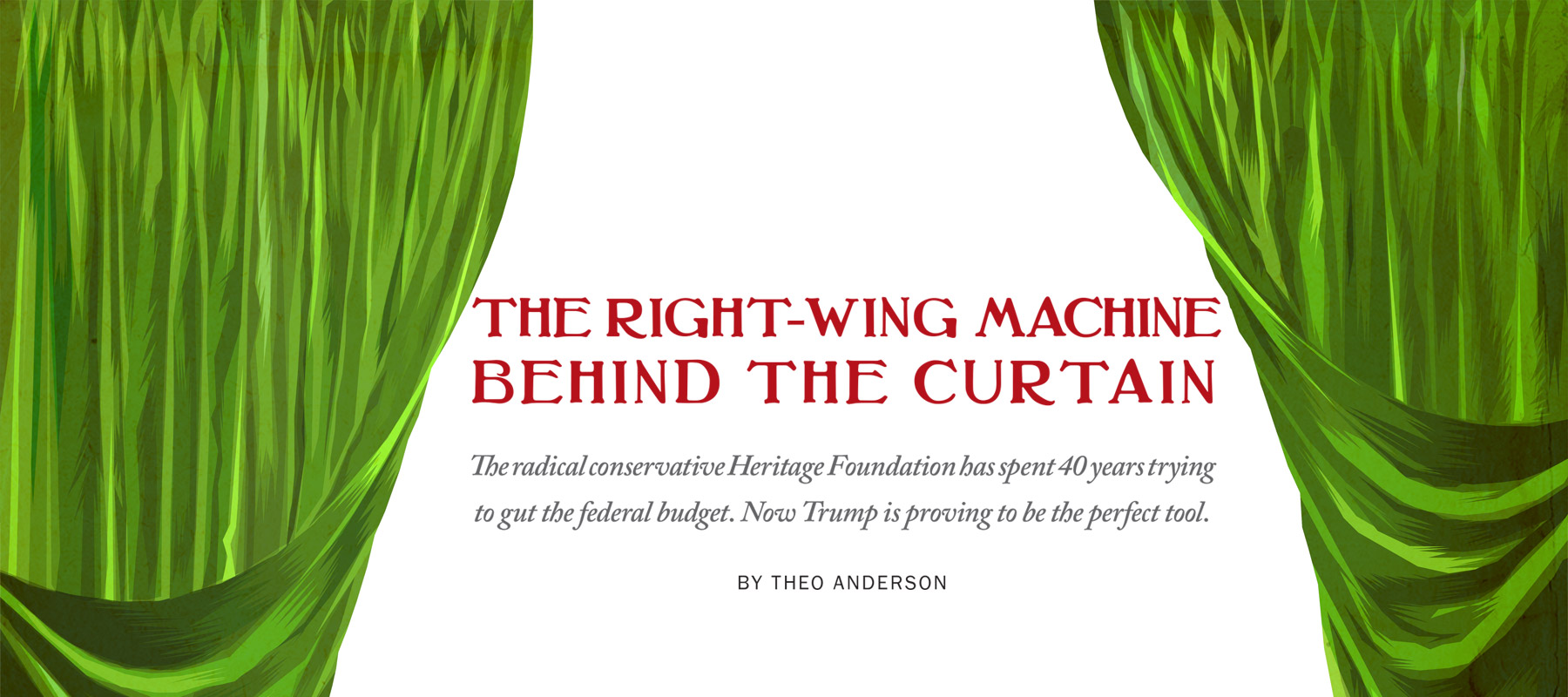

The radical conservative Heritage Foundation has spent 40 years trying to gut the federal budget. Now Trump is proving to be the perfect tool.
March 14, 2017 | April issue
The mood was jubilant two days after the November 2016 election at a Washington, D.C., panel co-hosted by two powerhouse conservative thinktanks—the American Enterprise Institute and the Heritage Foundation.
In his opening remarks, Heritage president Jim DeMint rejoiced that Donald Trump’s election had “preserved our constitutional republic.” Panelist John Yoo, a Berkeley law professor best known as the architect of George W. Bush’s justification for torture, drew laughs with feigned surprise at the audience size. “I thought everyone at Heritage was working over at transition head quarters,” Yoo quipped. “I asked the taxi cab driver to take me to Trump transition headquarters, and he dropped me off here.”
Indeed, Politico reported in November that Heritage, based in D.C., had become “a crucial conduit between Trump’s orbit and the once-skeptical conservative leaders who ultimately helped get him elected.” By Heritage’s own account, “several dozen” of its staff members worked on the transition team, and Trump used its recommendations for his list of potential Supreme Court picks.
Vice President Mike Pence, the head of that transition team, has deep ties to the foundation. In 2006, Heritage co-founder Paul Weyrich, a mentor of Pence’s, said of him, “Nobody is perfect, but he comes pretty close.” In early December, Pence gave the keynote speech at a Heritage event (held at Trump’s D.C. hotel) to honor its biggest donors. He promised that the Trump administration “is now and will continue to draw on” the institution’s work.
Heritage defines its mission as creating “an America where freedom, opportunity, prosperity and civil society flourish.” It has an annual budget of about $100 million and a staff of about 90 “experts” who hold such pseudo-academic titles as “research fellow’ and “policy analyst.” One example is libertarian economist Stephen Moore, a Trump advisor and a Heritage “distinguished visiting fellow.”
Heritage’s ties to the administration have received relatively little press. With its academic gloss, it may seem benign set against the extremism and zaniness that dominate the headlines: a press secretary only marginally less bizarre than the Saturday Night Live spoof of him; a key advisor who embraces the role of Darth Vader; cabinet picks who have promised to abolish the institutions they lead; executive orders that stigmatize Muslims and violate the Constitution; attacks on the press as “the enemy of the American people”; and on and on.
Yet a grim reality underlies the White House circus. Trump’s election is the culmination of a radical right-wing movement that began with the founding of Heritage in 1973. “We are different from previous generations of conservatives,” Weyrich said in the early 1980s. “We are radicals, working to overturn the present power structure of this country.”
Trump is that movement’s best hope yet for achieving its great dream of gutting government. Heritage isn’t an appendage of the Trump administration’s radicalism. It’s the heart of it. Trump is just a tool.


Illustration by Matthew Laznicka
Back to the future
We’ve been here before. When Ronald Reagan took office in 1981, Heritage published a 3,000-page opus, Mandate for Leadership, that gave the new administration some 2,000 specific policy recommendations. The overarching goals were cutting taxes and dramatically reducing the size of the federal government. Reagan not only took the advice seriously, he distributed copies to his cabinet.
For all that, Reagan had only modest success. His tax cuts were an easier sell than deep cuts to federal programs, which met stiff resistance in the Democratic-controlled House. By the end of the Reagan era, the federal government had actually grown, and domestic discretionary spending had increased at roughly the rate of inflation. While Reagan had promised to abolish the Department of Education, for example, overall spending on the department rose about 30 percent.
Much of this history has been forgotten or forgiven by the Right in the haze of idolatry that envelopes Reagan. But in 1988, libertarian scholar Sheldon Richman summed up the far-right’s disenchantment in an essay titled “The Sad Legacy of Ronald Reagan.” He noted, “The number of free-market achievements by the administration are so few that they can be counted on one hand—with fingers left over.”
And yet, with the help of Reagan, Heritage’s vision won out in another way: It came to define the GOP’s ideology and messaging. It translated conservative Christians’ fears and prejudices into a positive message: American freedom was in danger and needed to be protected. Every manner of dogma, religious as well as libertarian, could be smuggled into the public sphere under that banner. Republican politicians have slashed social supports for the most vulnerable, hollowed out the middle class and enriched the rich, all in the name of American liberty.
Another word for nothing left to lose
In 1973, Weyrich, a 30-year-old Republican strategist wunderkind, cofounded both the Heritage Foundation and the American Legislative Exchange Council, an organization that writes right-wing bills for state legislatures. The beer baron Joseph Coors provided seed money for the projects.

Paul Weyrich, pictured here at his Washington office in 1986, co-founded the Heritage foundation. (Photo: Susan Biddle/The Denver Post via Getty Images)
Weyrich’s dogged institution-building was driven by a burning vision: Organize evangelical Christians into a powerful voting bloc, reinvent the Republican Party and radically reconstruct the nation. In the late 1970s, he used anger over encroachments on “religious liberty”—namely, the liberty to deny African Americans entrance to religious private schools—to mobilize the Christian Right. His efforts propelled Reagan to victory in 1980 via another organization Weyrich cofounded, the Moral Majority.
Weyrich, who belonged to a Catholic sect, spoke a language of personal responsibility that resonated with evangelicals. He believed that individualism was the heart of the Judeo-Christian tradition and its great nemesis was the growth of government. “In all of the teachings of the New Testament, you never heard Jesus Christ say that it’s the responsibility of society or it’s the responsibility of government to take care of this,” Weyrich told the PBS show Frontline in 1996. “He always said, ‘It is your responsibility.’ When he talked to the rich man, he told the rich man it was his responsibility to divest himself of some of his riches to help the poor and so on. It was never a case of asking government to intervene.”
Yet Weyrich knew that building a conservative movement powerful enough to reshape the country would require reaching beyond a base of conservative evangelicals. The key, he wrote in the mid-1970s, was to present conservatism “in moral terms … packaged in non-religious language.”
Reagan, who had a sunny demeanor and was friendly with evangelicals, was the perfect vehicle. He may not have slashed the federal government, but the avuncular Reagan was a master storyteller who brought evangelical Christians together with free market capitalists by defining America’s greatness as its love of freedom. The godless Soviet Union and the godless, bloated U.S. federal government posed a double-barreled threat to that freedom. The great challenge for the conservative movement was to return power to the freedom-loving states.
That rallying cry has meant different things to different members of the right-wing coalition. For religious conservatives, freedom means getting the government out of their lives. Heritage has for years been knee-deep in the religious liberty crusade of the Christian Right. Its online publication, The Daily Signal, which claims to have more than 2 million readers, spotlights what it considers outrageous government intrusions on Christians’ rights, especially their right to discriminate against LGBT people. These stories often involve the travails of fundamentalist bakers, florists and wedding planners.
For libertarians and corporate conservatives, freedom means low taxes and little or no regulation. When the influential libertarian economist Milton Friedman died in 2006, Heritage posted a tribute to him on its website, claiming that “his powerful insights” had “saved millions or billions of people from decades of oppressive statism.”
Seizing the helm
For Heritage, the early years of the Obama administration were pivotal. By its own account, it “led the intellectual fight against Obamacare … even when the Washington establishment urged otherwise.” Through this crusade, it became tightly linked with the Tea Party. It also became much more directly engaged in elections, founding an electoral politics unit, Heritage Action, in 2010. Heritage Action spent $550,000 in 2013 targeting Republican House members who wouldn’t agree to oppose any government funding bill that included money for Obamacare. In 2013, Sen. Jim DeMint (R-S.C.) resigned to become Heritage’s president, touring the country taunting “moderate” Republicans who balked at a government shutdown.
In October 2013, the Tea Party and Heritage succeeded in shutting down the federal government for 16 days. But the shutdown achieved little aside from tanking the GOP’s approval ratings and stirring bitter feelings toward Heritage among the party’s less radical members. In the fall of 2013, Mickey Edwards, a former representative from Oklahoma and founding trustee of Heritage, told The Atlantic that its activist turn was “destroying the reputation and credibility” of the foundation.
But with Trump’s election in November, Heritage—an institution that defines freedom as the elimination of government—has become a key power broker in Washington and found an administration willing to further its agenda. At the Conservative Political Action Conference in late February, Trump advisor Steve Bannon said that the administration’s priority was the “deconstruction of the administrative state.”
It’s the old Tea Party push for a government shutdown, by other means.
Heritage’s impact will be felt in the Trump administration’s budget proposal, expected in mid-March. Last year, Heritage published a blueprint for bringing the federal budget into balance that calls for reducing spending by $10.5 trillion and cutting taxes by $1.3 trillion over a decade. It aims a wrecking ball at virtually every law, program and institution that defends the environment or promotes green energy. It calls for opening up “all federal waters and all non-wilderness, non federal-monument lands to exploration and production” to fossil fuel, mining and other commercial interests. According to Greenpeace, Heritage received at least $780,000 from ExxonMobil between 1998 and 2012, and more than $5.7 million from foundations associated with fossil-fuel industrialists the Koch brothers between 1997 and 2014.
The Trump administration is widely expected to adopt much of that blueprint as its own. Paul Winfree, the former director of Heritage’s Institute for Economic Policy Studies, was named the White House director of budget policy. Heritage noted in late February that Winfree is “expected to play the starring role in drafting Trump’s first budget. … The proposal will likely include deep spending cuts at domestic agencies.” According to Politico, Trump plans to cut the Environmental Protection Agency by about one-fourth, or roughly $2 billion.
The Heritage influence can be seen in non-budgetary ways, too. Speaking at the annual National Prayer Breakfast in early February, Trump said he would “totally destroy” the Johnson Amendment, an IRS rule that prevents nonprofit organizations, including churches, from endorsing political candidates. The call to repeal it has been a consistent theme of Heritage. A September 2016 essay in The Daily Signal argued that pastors “should be accountable to God alone, not the IRS, for what they say behind the pulpit.”
Freedom isn’t free
We can only guess at the havoc of the coming gouging of the federal budget, but several red states provide a clue to what “freedom” looks like in practice.
The Tea Party helped propel a Republican landslide in the 2010 midterm elections. It picked up 19 new statehouse chambers, giving it 55 overall and full control in 25 states. That takeover cleared the way for ALEC—Heritage’s state-level sister organization—to push through right-wing legislation.
States like Kansas and Wisconsin get most of the spotlight: Kansas because its governor, Sam Brownback, very proudly and aggressively made his state an experiment in “economic freedom,” and Wisconsin because the ALEC model cuts directly against its long tradition of progressivism. But Indiana, in its own quiet way, has been at the cutting edge of this rightward push under its last two governors—Mitch Daniels, who served from 2005 to 2013, and his successor, Mike Pence.

Then-Indiana Gov. Mike Pence, a Heritage darling, plugs his controversial Religious Freedom Restoration Act at a press conference on March 31, 2015. (Photo: Aaron P. Bernstein/Getty Images)
In 2011, through ALEC’s influence, Indiana became the first state to prohibit its cities and towns from raising their minimum wages. About 20 states have followed its lead. And in 2012, Indiana was at the leading edge of a new wave of union-busting “right-to-work” legislation. The laws allow workers to benefit from union representation without paying union dues.
Pence was likely thinking of these reforms, and of the cut in the state income tax he spearheaded, when he proclaimed in 2014 that Indiana was “blazing a trail for low taxes, balanced budgets and economic freedom in the Midwest.” In truth, Indiana was blazing a trail to the bottom. The state’s poverty rate rose by more than one third from 2007 to 2013, and the median household income declined nearly 11 percent. Indiana performed worse than any neighboring state on both counts.
One of Pence’s proudest achievements as Indiana governor was a budget surplus: Indiana closed the last fiscal year $2.24 billion in the black. That surplus came from Indiana’s failure to invest in public resources and institutions, which is to say, in the future. In the 2014-15 fiscal year, for example, its public health budget was just $12.40 per capita, or 46th in the nation—down from $17.43 per capita, and a rank of 37th, two years earlier. In 2015, it ranked in the top 15 in rates of tobacco use, obesity, diabetes and physical inactivity among adults. In a January 2017 Gallup and Healthways report on U.S. wellbeing across the states, Indiana placed 47th, based on a range of indicators that included financial, community and physical well-being.
Indiana’s fall from bad to worse illustrates the cycle of dysfunction that takes hold in states that apply the Heritage- and ALEC-driven model of economic freedom. Public investment declines, even as government passes laws to curb unions and suppress wage growth. The low wages hollow out the tax base, which means there is less money for public investment, which worsens things like public health and education. Their sad condition is then used to justify applying “free-market” reforms to the public sector.
Under Pence, Indiana was, naturally, at the forefront of the push for public-school privatization. It has the most robust voucher program in the nation—using taxpayer dollars to send students to private schools.
While Indiana’s right-to-work law passed before he took office, Pence did his part to advance ALEC’s wage-suppressing agenda. Pence consistently opposed any increase to the state’s $7.25 minimum wage. The Indiana Institute for Working Families calculated in 2015 that a hike to $10.10 would benefit about one-fourth of the state’s workforce. And in 2015, he pushed to repeal a law in effect since 1935 that mandated “prevailing wages” on construction projects, usually in line with union wages. In signing the repeal, Pence said that wages should be set by the marketplace.
The federal equivalent of that wage-protection law is the Davis-Bacon Act, which passed in 1931 and has long been in the crosshairs of conservatives, including Heritage.
The court of public opinion
The hollowing out of states like Indiana has been a major victory for the Right. As Heritage and its allies move to bring the same radical project to the federal level, the court of public opinion will be progressives’ most powerful tool.
“Freedom” may resonate with Americans as a slogan, but they hate the Right’s version of freedom in practice. When Trump tapped Pence as his running mate, he was among the most unpopular governors in the nation, with an in-state approval rating in the 40s. And when Trump threatened to repeal Obamacare, protests erupted. “They thought [repeal] was a slam dunk,” says Liz Ryan Murray, policy director for People’s Action, a progressive nonprofit. “They didn’t understand: People will fight for this. And I think the same thing will happen as the magnitude of these cuts becomes apparent.”
A vast amount needs to be done— by the grassroots, by the independent media, by the Democratic Party and by every other resource we can muster— in the realm of simple storytelling and education. The federal budget is a convenient target for demagogues because most Americans have little to no idea how it’s actually spent. PBS and NPR, for example, are about 0.01 percent of the budget. In surveys, people estimate they’re about 5 percent.
Progressives might take a page from Citizen Action of Wisconsin (CAW), which released a progressive “alternative budget” in advance of Gov. Walker’s own proposed budget. The goal, says CAW executive director Robert Kraig, is to make the case for “big investments that would strengthen every community across Wisconsin and improve opportunity for everyone.”
“We’re experimenting with trying to change the debate,” Kraig says. “The research is really clear that the way progressives often talk about problems with government actually undermines people’s regard for government and makes them feel hopeless and disengaged. So there needs to be a healthy dose of aspiration: What could we achieve?”
However the budget fight plays out, the most critical insight from the past half century of U.S. politics may be that conservatives have both a story and a long-term vision that lets them take losses in stride, fortified with plenty of funding. The movement originated in the aftermath of what seemed like conservatism’s collapse through the 1950s and 1960s. Among Weyrich’s greatest gifts, said Ed Feulner, the former president of Heritage, was an “unerring eye for spotting the path to victory in the midst of seeming disaster.”
Heritage’s use of an ideological cipher like Trump to carry out an agenda that seemed hopelessly stuck just four years ago is the latest example of the movement’s resilience. If Trump is impeached and removed from office, they will be happy to have Pence.
If there is much to rage against in the Right’s agenda, there is also a perverse element of hope for progressives in the story of its 50-year ascent. The seeds of long-term success, it turns out, can take root and grow in the midst of seeming disaster. 
Theo Anderson an In These Times staff writer, has contributed to the magazine since 2010 and is currently a Schumann Center writing fellow. He has a Ph.D. in modern U.S. history from Yale and is working on a book about the intellectual and religious origins of conservatism and progressivism.
Want more independent news and analysis? Subscribe to the free In These Times weekly newsletter:
